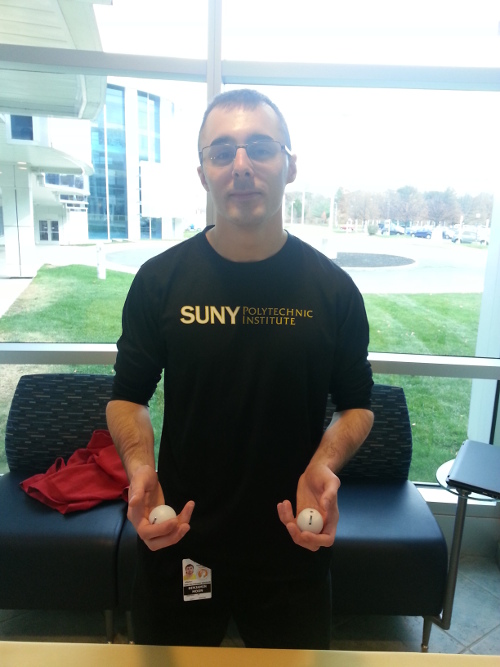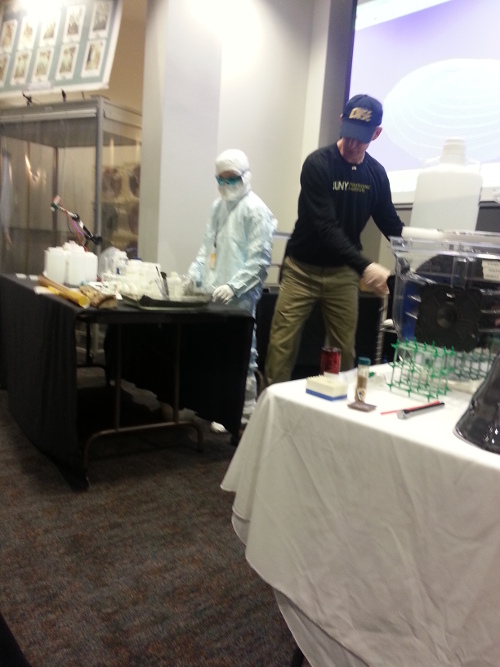SUNY Polytechnic hosted the SUNY Poly Community Day at NanoTech Complex last weekend, as part of their annual NaNovember event. A similar event was held at SUNY’s Utica site.
There were people of all ages and groups. Magentic levitation, magic show, trick questions, guided tour of the facility – there was something for everyone interested in science & technology.
If you attended it, as soon as you walked in, you would have seen Benjamin Moon with two “special balls” in his hands. The balls were placed on two separate surfaces. Then you were supposed to touch on the surfaces and feel the temperature. One felt like it was very cold, while the other was almost at room temperature.
“Which one is colder?”
“Well, the one on the left seems to be cold”.
“Not really, it absorbs heat faster. So it feels cold to touch it. Now, which one will warm up faster?”
“Umm..the one on the right?”
“Not really. The cold one on the left, because it absorbs heat faster!”
Physics 101. 🙂

He later also showed how to make polymer worms.
Magnetic Levitation
One of the biggest attractions was magetic levitation, demonstrated by Graeme Housser (SUNY College of Nanoscale Science and Engineering). A metal block was dipped into liquid in a container, and was then placed over a “rail track”. It stayed in the air, without touching the tracks.
So how does it work? The “metal block” is a compound made of YBCO (Yttrium barium copper oxide). The “liquid” is no ordinary liquid – it is liquid nitrogen. By dipping the block in liquid nitrogen, its temperature drops, and it starts superconducting. YBCO is in fact one of the very few materials which can superconduct above the boiling point of liquid nitrogen.
Magnetic Levitation – Part 1
Magnetic Levitation – Part 2
Magnetic Levitation – Part 3
Introduction to Nanotechnology
Dr. Alain Diebold, the Dean of the College of Nanoscale Science, gave an overview of nanotechnology in one of the morning sessions.
Considering the fact that he was leading some pretty advanced research, he was able to convey complex concepts using simple language very well.
He started off by displaying everyday items which have nanotechnology in them. This was followed by an overview of the divisions of nanotechnology at the SUNY Polytechnic Institute (Albany): nanoscience, nanoengineering, nanoeconomics, and nanobioscience.
The bucky ball structure, its applications, the CNSE buildings, companies which do R&D there, and a lot of other things were covered. A picture taken by the SUNY Poly microscope was one of the highlights.
He engaged the audience very well, which led to this interesting exchange (paraphrased):
“Which among nanoscience, nanoengineering, nanoeconomics, and nanobioscience do you like the most, sir?”
“Well, I am the Dean, so I have to be careful while answering this. Other than the fact that I work with semiconductors when I do my research, I don’t have a favorite. Consider this: Do you know a doctor who knows all specialities?”
“Yes”, someone answered from the audience.
Wow. Whoever it was, should try his luck at lottery.
Another question was about organic and biological computing. Dr. Alain Diebold said his colleague is doing some research which involved photoresistors. Someone else was working on something which involved fighting cancer.
Cleanroom gown – demo
Mr. Stephen Lynn Stewart, who is an instructional support technician at SUNY Poly, was in charge of this. Photoresistors, seed crystals, silicon’s structure, crystalline structure of diamonds and graphite, cloud edges, silicon wafers, and a lot of other topics were covered in this fast paced and entertaining session.
The cleanroom gown demo, and other demos, were done with the help of volunteers.

Static electricity
Logan Butt, student at SUNY Poly, was doing this demo of a strip being repelled by static electricity. It is better to see it in action:
When the belt grinds against the material inside, it creates static charge, and as always, negative repels negative.
Light using Squishy Circuits
Jenny and Denise from TechValley High School demonstrated how to light up a diode using candy(Update: thanks for the correction, Denise!) dough. More specifically, conducting dough and insulating dough. Both can be made using flour as the primary ingredient, as described here and here.
You can find out about Squishy Circuits here: Squishy Circuits Project
Students can apply to attend Tech Valley High School during eighth grade. The brochure is available here: Download Tech Valley High School Brochure (PDF) .
Cleanroom Tour
Cleanroom tours (NanoFab buildings) were conducted every 20 minutes. Ms. Wenli Collison was our guide. The clean rooms have glass windows, and so are visible from outside.
Ms. Collison gave an excellent overview of the nanotech industry and answered the questions everyone had.
One question (which came up during Dr. Alain Diebold’s presentation as well) was: Where does the dust go in the clean rooms? Ms. Collison explained that the air comes from above, and passes through filters, and flows down such that dust goes down to the basement section. There is minimal humidity in the rooms.
Some facts which Ms. Collison revealed:
- The leading chip companies are TSMC, Samsung, Globalfoundries, and Intel. They work together, in partnership with SUNY, for conducting R&D, thus reducing the total cost.
- The 450 mm wafer which was displayed there is not generally available anywhere else in the world.
- The equipment to produce the wafer costs many, many millions of dollars.
- Having a clean room is very essential to manufacturing these chips.
- The decision to move from 300 mm to 450 mm is taken based on cost considerations.
- Almost every tool involved in the design will have to be redesigned everytime they decide to increase the diameter of the wafer. This means, increasing the diameter of the wafer will be a very expensive process, almost everytime.
- SUNY Polytechnic Institute is looking for researchers and interns. The interns and researchers will get a chance to work with world’s leading companies on technologies which will not become available to the general public for many years.
The tour was very informative. It is not everyday that you get a chance to get your questions answered by a specialist with a Ph.D. in plasma physics and 12 patents. Yes, Ms. Wenli Collison has a very impressive resume. Just like most of the faculty & staff at SUNY.
About Nanotechnology
Nanotechnology deals with control of matter about 100 nanometres or smaller – in other words, control of matter at a molecular or even atomic scale. It involves many different subjects, like physics, material science, chemistry, robotics, chemical engineering, mehanical engineering, biological engineering, and electrical engineering.
About SUNY Polytechnic Institute
The State University of New York Polytechnic Institute (also known as SUNY Polytechnic Institute or SUNY Poly) is New York’s public polytechnic college, with campuses in Marcy and Albany. Accredited by the Middle States Association of Colleges and Schools, SUNY Poly offers over 30 bachelor’s and associates’ degrees, 15 master’s degrees, and three doctoral degrees within five different colleges. SUNY Poly students come from more than twenty nations. Find out more about SUNY (CNSE) undergraduate admissions process here. Find out more about SUNY (CNSE) graduate programs here.
About NaNovember and SUNY Poly Community Day
NaNovember is a month-long event, being held for the eighth time. SUNY Polytechnic Institute organizes it every year, mainly to bring awareness to the public about nanotechnology, while showcasing the leading status of SUNY Poly and the state of New York. SUNY Poly Community Day held at Albany and Utica campuses simultaneously was part of NaNovember, providing the general public a chance to see the amazing world of nanotechnology in action.
Did you get lucky with upside down levitation? The video stops there.